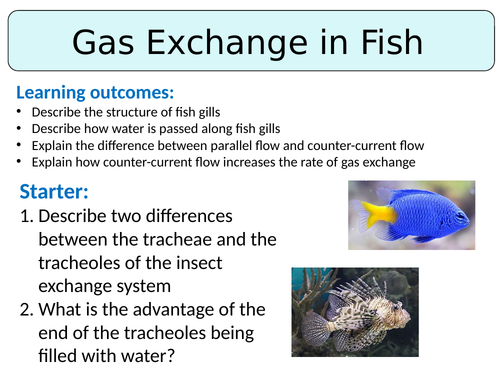

This lesson is designed for the NEW AQA AS-level Biology course, particularly the ‘Organisms & their Environment’ module.
For more lessons designed to meet specification points for the NEW AQA A-level Biology course please visit my shop: https://www.tes.com/teaching-resources/shop/SWiftScience
A-Level lesson format: I teach in more of a lecture style compared to GCSE. In the majority of my A-level lessons the beginning portion of the lesson is mainly teacher-led, where students are expected to take notes onto a handout/in their books. This is then mixed in with student-led activities, as well as questions and exam prep.
You will find some of my slides have blank spaces for you to add more detail/descriptions/explanations. If you look at the ‘Notes’ section underneath each of these slides, you will find additional content which you can add in as you teach!
This lesson on the gas exchange processes in fish begins with a quick review of the insect exchange system and the advantage of tracheoles being filled with water.
Students are then introduced the exchange properties of fish; they should discuss as a class how fish supply respiratory gases to cells within their body tissues. They will then watch a short video and answer exam style questions based on the video.
This activity should help students be prepared for a function/feature matching activity; answers are available on the following slide for self-assessment.
The next task is to complete sentences explaining the process of gas exchange in fish and defining the features and functions of fish. Answers are on the following slide for self-assessment!
Students are then introduced to the counter-current exchange. They should take thorough notes and understand the importance of the process. A video link is available in the notes in order to help consolidate. A worksheet with the appropriate diagrams is included.
The following slide reiterates the difference between parallel and counter current flow. Points to note for an exam question are in the notes below, students will have the opportunity to answer exam style questions in the next task and answers are available for self-assessment.
This lesson features a lab task for students to dissect and observe gas exchange surfaces in a bony fish. The method is set out on the slides.
The lesson ends with a plenary, students should complete an exit card sharing 3 things they’ve learnt, 5 key words, and 1 question to test their peers.
All resources are included. Thanks for looking, if you have any questions please let me know in the comments section and any feedback would be appreciated :)
Something went wrong, please try again later.
This resource hasn't been reviewed yet
To ensure quality for our reviews, only customers who have purchased this resource can review it
Report this resourceto let us know if it violates our terms and conditions.
Our customer service team will review your report and will be in touch.